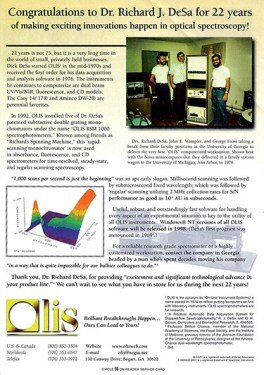Getting The Uv/vis To Work
Table of ContentsThe Main Principles Of Circular Dichroism Some Known Factual Statements About Uv/vis/nir Not known Details About Spectrophotometers Some Known Details About Uv/vis/nir About Spectrophotometers

Spectrophotometry is a tool that hinges on the quantitative analysis of particles depending on how much light is absorbed by colored compounds.
Not known Incorrect Statements About Circularly Polarized Luminescence
A spectrophotometer is typically utilized for the measurement of transmittance or reflectance of options, transparent or nontransparent solids, such as refined glass, or gases. Although lots of biochemicals are colored, as in, they take in noticeable light and therefore can be measured by colorimetric treatments, even colorless biochemicals can typically be converted to colored substances appropriate for chromogenic color-forming responses to yield substances suitable for colorimetric analysis.: 65 However, they can likewise be created to measure the diffusivity on any of the noted light ranges that generally cover around 2002500 nm using various controls and calibrations.
An example of an experiment in which spectrophotometry is utilized is the determination of the equilibrium constant of an option. A particular chain reaction within an option may happen in a forward and reverse instructions, where reactants form products and products break down into reactants. Eventually, this chain reaction will reach a point of balance called an equilibrium point.
How Spectrophotometers can Save You Time, Stress, and Money.
The amount of light that passes through the option is a sign of the concentration of certain chemicals that do not permit light to go through. The absorption of light is due to the interaction of light with the electronic and vibrational modes of molecules. Each type of particle has a private set of energy levels associated with the makeup of its chemical bonds and nuclei and therefore will absorb light of specific wavelengths, or energies, leading to unique spectral homes.
They are widely used in numerous markets including semiconductors, laser and optical production, printing and forensic examination, as well as in labs for the study of chemical compounds. Spectrophotometry is frequently used in measurements of enzyme activities, decisions of protein concentrations, determinations of enzymatic kinetic constants, and measurements of ligand binding reactions.: 65 Ultimately, a spectrophotometer is able to identify, depending on the control or calibration, what compounds are present in a target and exactly how much through i loved this estimations of observed wavelengths.
Created by Arnold O. Beckman in 1940 [], the spectrophotometer was produced with the aid of his colleagues at his business National Technical Laboratories established in 1935 which would end up being Beckman Instrument Business and eventually Beckman Coulter. This would come as a solution to the previously produced spectrophotometers which were unable to absorb the ultraviolet properly.
Our Circularly Polarized Luminescence PDFs
It would be discovered that this did not provide acceptable results, for that reason in Design B, there was a shift from a glass to a quartz prism which permitted better absorbance outcomes - circular dichroism (http://www.video-bookmark.com/bookmark/6114703/olis-clarity/). From there, Model C was born with a change to the wavelength resolution which ended up having three units of it produced
It irradiates the sample with polychromatic light which the sample absorbs depending upon its residential or commercial properties. Then it is sent back by grating the photodiode array which finds the wavelength area of the spectrum. Ever since, the development and implementation of spectrophotometry gadgets has actually increased exceptionally and has become one of the most innovative instruments of our time.

Some Known Facts About Spectrophotometers.
The grating can either be movable or fixed.
In such systems, the grating is repaired and the intensity of each wavelength of light is determined by a different detector in the selection. Furthermore, most modern-day mid-infrared spectrophotometers utilize a Fourier change strategy to get the spectral information - https://www.4shared.com/u/FvsNFVfH/julieanndesalorenz30606.html. This strategy is called Fourier change infrared spectroscopy. When making transmission measurements, the spectrophotometer quantitatively compares the fraction of light that goes through a reference service and a test solution, then digitally compares the strengths of the 2 signals and calculates the percentage of transmission of the sample compared to the referral standard.
